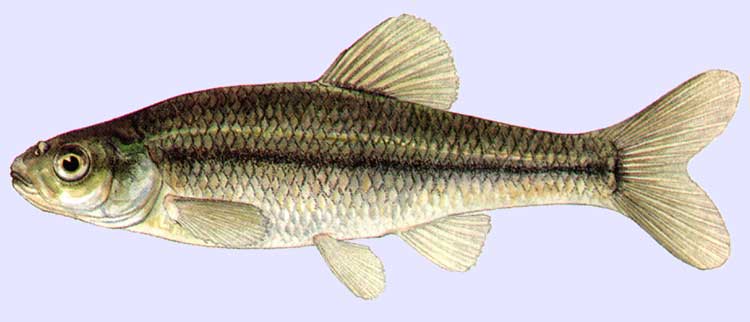Pimephales promelas Cladus: Eukaryota The fathead minnow (Pimephales promelas), is a species of temperate freshwater fish belonging to the Pimephales genus of the cyprinid family. The natural geographic range extends throughout much of North America, from central Canada south along the Rockies to Texas, and east to Virginia and the Northeastern United States.[1] This minnow has also been introduced to many other areas via bait bucket releases. Its golden, or xanthic strain, known as the rosy-red minnow, is a very common feeder fish sold in the United States. This fish is best known for producing Schreckstoff. Physical description The fathead minnow in its wild form is generally dull olive-grey in appearance, with a dusky stripe extending along the back and side, and a lighter belly. There is a dusky blotch midway on the dorsal fin. Breeding males acquire a large, grey fleshy growth on the nape, as well as approximately 16 white breeding tubercles on the snout.[1][2] The fathead is quite tolerant of turbid, low-oxygentated water, and can be found in muddy ponds and streams that might otherwise be inhospitable to other species of fish. It can also be found in small rivers.[3][4] The fathead has been very commonly used as a baitfish, and more recently has emerged in the aquarium trade as the rosy-red minnow. This color morph was discovered in several Arkansas breeding farms in 1985. Both sexes of this strain have a rosy-golden body and fins, and are sold in pet shops primarily as feeder fish. They can also be used in home aquariums as pets.[4] This species is also important as a biological model in aquatic toxicology studies. Because of its relative hardiness and large number of offspring produced, EPA guidelines outline its use for the evaluation of acute and chronic toxicity of samples or chemical species in vertebrate animals.[5] The fathead's invasive status in Europe is cited as the main cause for the spread of enteric redmouth disease among trout and eels there.[3] In the aquarium and ornamental pond Generally only the rosy-red variety is sold in pet shops (though very often several wild types come in with each shipment), and is summarily the most likely to be found in an aquarium. These fish are social, active, and moderately hardy. Like most cyprinids, they will accept almost any type of food. They can be bred in an aquarium, and the fathead minnow is one of the only cyprinids that protects its eggs in the nest (carried out by the male). Fatheads will live about two years if they have spawned, but significantly longer (potentially up to four years) if they have not.[6] These fish prefer a temperature of 10 - 21 °C (50 - 70 °F) and a pH range of 7.0 - 7.5.[2][4] References ^ a b Page, Lawrence M. and Brooks M. Burr (1991), Freshwater Fishes, p. 129-130, Houghton Mifflin, New York, NY. ISBN 0-395-91091-9 Source: Wikipedia, Wikispecies: All text is available under the terms of the GNU Free Documentation License |
|

